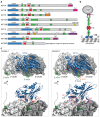Intracellular Cargo Transport by Kinesin-3 Motors
- PMID: 28918744
- PMCID: PMC7612238
- DOI: 10.1134/S0006297917070057
Intracellular Cargo Transport by Kinesin-3 Motors
Abstract
Intracellular transport along microtubules enables cellular cargoes to efficiently reach the extremities of large, eukaryotic cells. While it would take more than 200 years for a small vesicle to diffuse from the cell body to the growing tip of a one-meter long axon, transport by a kinesin allows delivery in one week. It is clear from this example that the evolution of intracellular transport was tightly linked to the development of complex and macroscopic life forms. The human genome encodes 45 kinesins, 8 of those belonging to the family of kinesin-3 organelle transporters that are known to transport a variety of cargoes towards the plus end of microtubules. However, their mode of action, their tertiary structure, and regulation are controversial. In this review, we summarize the latest developments in our understanding of these fascinating molecular motors.
Figures


Similar articles
-
Kinesin-1, -2, and -3 motors use family-specific mechanochemical strategies to effectively compete with dynein during bidirectional transport.Elife. 2022 Sep 20;11:e82228. doi: 10.7554/eLife.82228. Elife. 2022. PMID: 36125250 Free PMC article.
-
Multiple kinesins induce tension for smooth cargo transport.Elife. 2019 Oct 31;8:e50974. doi: 10.7554/eLife.50974. Elife. 2019. PMID: 31670658 Free PMC article.
-
The types and numbers of kinesins and dyneins transporting endocytic cargoes modulate their motility and response to tau.J Biol Chem. 2024 Jun;300(6):107323. doi: 10.1016/j.jbc.2024.107323. Epub 2024 Apr 25. J Biol Chem. 2024. PMID: 38677516 Free PMC article.
-
Molecular motor proteins of the kinesin superfamily proteins (KIFs): structure, cargo and disease.J Korean Med Sci. 2004 Feb;19(1):1-7. doi: 10.3346/jkms.2004.19.1.1. J Korean Med Sci. 2004. PMID: 14966333 Free PMC article. Review.
-
Move in for the kill: motile microtubule regulators.Trends Cell Biol. 2012 Nov;22(11):567-75. doi: 10.1016/j.tcb.2012.08.003. Epub 2012 Sep 6. Trends Cell Biol. 2012. PMID: 22959403 Free PMC article. Review.
Cited by
-
Kinesin-directed secretion of basement membrane proteins to a subdomain of the basolateral surface in Drosophila epithelial cells.Curr Biol. 2022 Feb 28;32(4):735-748.e10. doi: 10.1016/j.cub.2021.12.025. Epub 2022 Jan 11. Curr Biol. 2022. PMID: 35021047 Free PMC article.
-
Editorial: Microtubule-associated molecular motors: Transport mechanisms and role in disease.Front Cell Dev Biol. 2022 Dec 7;10:1106435. doi: 10.3389/fcell.2022.1106435. eCollection 2022. Front Cell Dev Biol. 2022. PMID: 36568971 Free PMC article. No abstract available.
-
Polyglutamylation of tubulin's C-terminal tail controls pausing and motility of kinesin-3 family member KIF1A.J Biol Chem. 2019 Apr 19;294(16):6353-6363. doi: 10.1074/jbc.RA118.005765. Epub 2019 Feb 15. J Biol Chem. 2019. PMID: 30770469 Free PMC article.
-
Association of microtubules and axonal RNA transferred from myelinating Schwann cells in rat sciatic nerve.PLoS One. 2020 May 29;15(5):e0233651. doi: 10.1371/journal.pone.0233651. eCollection 2020. PLoS One. 2020. PMID: 32469980 Free PMC article.
-
Control of motor landing and processivity by the CAP-Gly domain in the KIF13B tail.Nat Commun. 2023 Aug 5;14(1):4715. doi: 10.1038/s41467-023-40425-4. Nat Commun. 2023. PMID: 37543636 Free PMC article.
References
-
- Hall DH, Hedgecock EM. Kinesin-related gene unc-104 is required for axonal transport of synaptic vesicles in C.elegans . Cell. 1991;65:837–847. - PubMed
-
- Otsuka AJ, Jeyaprakash A, Garcia-Anoveros J, Tang LZ, Fisk G, Hartshorne T, Franco R, Born T. The C. elegans unc-104 gene encodes a putative kinesin heavy chain-like protein. Neuron. 1991;6:113–122. - PubMed
Publication types
MeSH terms
Substances
Grants and funding
LinkOut - more resources
Full Text Sources
Other Literature Sources

